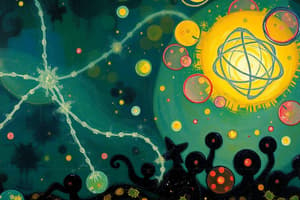Podcast
Questions and Answers
What is Chapter 2 about?
What is Chapter 2 about?
- Marine Biology
- Human Anatomy
- The Biology of Plants
- The Chemistry of Life (correct)
Which of the following is NOT one of the six elements that make up the majority of living organisms?
Which of the following is NOT one of the six elements that make up the majority of living organisms?
- Potassium (correct)
- Hydrogen
- Oxygen
- Carbon
What do atoms contain?
What do atoms contain?
Negatively charged electrons
What is the charge of an atom as a whole?
What is the charge of an atom as a whole?
What forms when atoms gain or lose electrons?
What forms when atoms gain or lose electrons?
What do Carbon-12 and Carbon-14 have in common?
What do Carbon-12 and Carbon-14 have in common?
What type of bond do sodium and chlorine form?
What type of bond do sodium and chlorine form?
What type of bond exists between carbon and hydrogens in CH4?
What type of bond exists between carbon and hydrogens in CH4?
What rule states that 8 electrons in the valence shell make an atom stable?
What rule states that 8 electrons in the valence shell make an atom stable?
What type of lipid registers a 5 on the pH scale?
What type of lipid registers a 5 on the pH scale?
What is the most acidic solution?
What is the most acidic solution?
In a glass of lemonade, what is sugar considered?
In a glass of lemonade, what is sugar considered?
What must molecules contain to be classified as organic?
What must molecules contain to be classified as organic?
What carbon-based molecule stores genetic information?
What carbon-based molecule stores genetic information?
What are types of lipids?
What are types of lipids?
What two types of organic molecules mainly function as an energy source for living organisms?
What two types of organic molecules mainly function as an energy source for living organisms?
When do atoms in molecules share pairs of electrons?
When do atoms in molecules share pairs of electrons?
What type of bond forms when a metal transfers one or more electrons to a non-metal?
What type of bond forms when a metal transfers one or more electrons to a non-metal?
What is a weak attraction between slightly positive hydrogen atoms and slightly negative atoms called?
What is a weak attraction between slightly positive hydrogen atoms and slightly negative atoms called?
What is the attraction between molecules of the same substance called?
What is the attraction between molecules of the same substance called?
What measures acidity related to the free hydrogen ion concentration in a solution?
What measures acidity related to the free hydrogen ion concentration in a solution?
What is the general name for a large, carbon-based molecule formed by monomers?
What is the general name for a large, carbon-based molecule formed by monomers?
What are the four main types of carbon-based molecules?
What are the four main types of carbon-based molecules?
Match the following polymers with their respective macromolecules: Triglyceride, RNA, Enzymes, Cellulose.
Match the following polymers with their respective macromolecules: Triglyceride, RNA, Enzymes, Cellulose.
What are the monomers of Triglyceride, RNA, Enzymes, and Cellulose?
What are the monomers of Triglyceride, RNA, Enzymes, and Cellulose?
What does it mean when we refer to Bacteria as prokaryotes?
What does it mean when we refer to Bacteria as prokaryotes?
In addition to bacteria, what is the other domain of life that consists of prokaryotes?
In addition to bacteria, what is the other domain of life that consists of prokaryotes?
Which one is not one of the three domains of life?
Which one is not one of the three domains of life?
What is the shape of rod-shaped bacteria called?
What is the shape of rod-shaped bacteria called?
What are spherical bacteria called?
What are spherical bacteria called?
What are worm-like bacteria called?
What are worm-like bacteria called?
What is a small, circular piece of genetic information inside a bacterial cell called?
What is a small, circular piece of genetic information inside a bacterial cell called?
How do prokaryotes move?
How do prokaryotes move?
What type of reproduction do bacteria use?
What type of reproduction do bacteria use?
What is the process through which bacteria multiply rapidly known as?
What is the process through which bacteria multiply rapidly known as?
What is any disease-causing microorganism called?
What is any disease-causing microorganism called?
Who discovered Penicillin, the first antibiotic ever used by humans?
Who discovered Penicillin, the first antibiotic ever used by humans?
How do antibiotics kill bacteria?
How do antibiotics kill bacteria?
What do antibiotics fight?
What do antibiotics fight?
What temperature range is considered the danger zone for bacterial growth?
What temperature range is considered the danger zone for bacterial growth?
What process kills bacteria by breaking down their cell walls?
What process kills bacteria by breaking down their cell walls?
What process slows down the bacteria's metabolism and growth?
What process slows down the bacteria's metabolism and growth?
What is the process of using heat to destroy microorganisms called?
What is the process of using heat to destroy microorganisms called?
What are some pasteurized foods?
What are some pasteurized foods?
What are the 5 steps food takes to get to us?
What are the 5 steps food takes to get to us?
How do bacteria benefit from living in a human digestive system?
How do bacteria benefit from living in a human digestive system?
Of the thousands of types of bacteria, how many cause disease?
Of the thousands of types of bacteria, how many cause disease?
Are all strains of E. coli pathogenic?
Are all strains of E. coli pathogenic?
Besides milk, how many types of food are pasteurized?
Besides milk, how many types of food are pasteurized?
Why are bacteria important?
Why are bacteria important?
How do antibiotics kill plant cells?
How do antibiotics kill plant cells?
Why does milk spoil at room temperature?
Why does milk spoil at room temperature?
What is a solvent?
What is a solvent?
What is a solute?
What is a solute?
What is a solution?
What is a solution?
What pH levels are considered acidic?
What pH levels are considered acidic?
Flashcards
Key Elements in Life
Key Elements in Life
Carbon, hydrogen, oxygen, nitrogen, phosphorus, and sulfur are essential for living organisms.
Ions
Ions
Ions are charged atoms formed by gaining or losing electrons.
Isotopes
Isotopes
Isotopes are atoms with the same proton number but varied neutron counts.
Ionic Bonds
Ionic Bonds
Signup and view all the flashcards
Covalent Bonds
Covalent Bonds
Signup and view all the flashcards
Octet Rule
Octet Rule
Signup and view all the flashcards
pH Scale
pH Scale
Signup and view all the flashcards
Solutions
Solutions
Signup and view all the flashcards
Organic Molecules
Organic Molecules
Signup and view all the flashcards
Nucleic Acids
Nucleic Acids
Signup and view all the flashcards
Lipids
Lipids
Signup and view all the flashcards
Polymers
Polymers
Signup and view all the flashcards
Monomers
Monomers
Signup and view all the flashcards
Prokaryotes
Prokaryotes
Signup and view all the flashcards
Bacteria Shapes
Bacteria Shapes
Signup and view all the flashcards
Plasmids
Plasmids
Signup and view all the flashcards
Flagella
Flagella
Signup and view all the flashcards
Binary Fission
Binary Fission
Signup and view all the flashcards
Pathogens
Pathogens
Signup and view all the flashcards
Antibiotics
Antibiotics
Signup and view all the flashcards
Danger Zone
Danger Zone
Signup and view all the flashcards
Cooking Bacteria
Cooking Bacteria
Signup and view all the flashcards
Chilling Effect
Chilling Effect
Signup and view all the flashcards
Pasteurization
Pasteurization
Signup and view all the flashcards
Digestive Bacteria
Digestive Bacteria
Signup and view all the flashcards
E. Coli
E. Coli
Signup and view all the flashcards
Food Pasteurization
Food Pasteurization
Signup and view all the flashcards
Study Notes
The Chemistry of Life
- Key elements in living organisms include carbon, hydrogen, oxygen, nitrogen, phosphorus, and sulfur; potassium is not a major component.
- Atoms consist of negatively charged electrons, positively charged protons, and neutral neutrons; when protons and electrons are equal, the overall charge is neutral.
- Ions are formed through the gain or loss of electrons by atoms.
Isotopes and Bonds
- Carbon-12 and carbon-14 are isotopes distinguished by different neutron counts while maintaining the same proton number.
- Sodium and chlorine form ionic bonds through the transfer of electrons, while carbon and hydrogen in CH4 are connected by covalent bonds.
pH and Acidity
- An octet of eight electrons in the valence shell confers stability on an atom.
- Solutions with a pH of 1 are considered the most acidic, and acidic substances have pH values below 7.
- In lemonade, sugar acts as the solute which dissolves in water, the solvent, creating a solution.
Organic Molecules
- Organic molecules must contain carbon.
- Nucleic acids are carbon-based molecules that store genetic information; they include DNA and RNA.
- Lipids, including fats, oils, and cholesterol, function as energy sources along with carbohydrates.
Molecular Structures
- Polymers, which consist of large carbon-based molecules formed from monomers, include triglycerides, RNA, enzymes, and cellulose.
- Monomers encompass fatty acids, monosaccharides, nucleotides, and amino acids contributing to the structure of respective polymers.
Prokaryotes and Bacteria
- Bacteria, classified as prokaryotes, are unicellular organisms whose DNA is not enclosed in a nucleus; archaea represent another domain of prokaryotes.
- Bacteria exhibit various shapes: bacilli (rod-shaped), cocci (spherical), and spirilla (worm-like), while "flagelli" is not a recognized shape.
Genetic Information and Reproduction
- Plasmids are small, circular DNA structures within bacterial cells, which can replicate independently of chromosomal DNA.
- Bacteria utilize flagella for movement and reproduce asexually through binary fission, allowing rapid population increases known as exponential growth.
Pathogens and Antibiotics
- Pathogens are microorganisms that cause diseases; only a small fraction of bacterial species are pathogenic.
- Alexander Fleming discovered penicillin, the first antibiotic, which disrupts bacterial cell walls, effectively targeting bacterial infections.
Food Safety and Bacteria
- The danger zone for bacterial growth is between temperatures of 40°F and 140°F.
- Cooking can kill bacteria by destroying their cell walls and enzymes, while chilling slows bacterial metabolism and growth.
- Pasteurization uses heat to eliminate disease-causing microorganisms and is applied to items like milk, orange juice, and eggs.
Role of Bacteria
- Most bacteria in the human digestive system provide nutritional benefits and habitat, contributing to processes such as nitrogen fixation and nutrient recycling.
- Although many bacteria inhabit the digestive system, only a small subset is harmful, with not all strains of E. coli being pathogenic.
- Beyond milk, numerous other types of food undergo pasteurization to ensure safety.
Studying That Suits You
Use AI to generate personalized quizzes and flashcards to suit your learning preferences.



